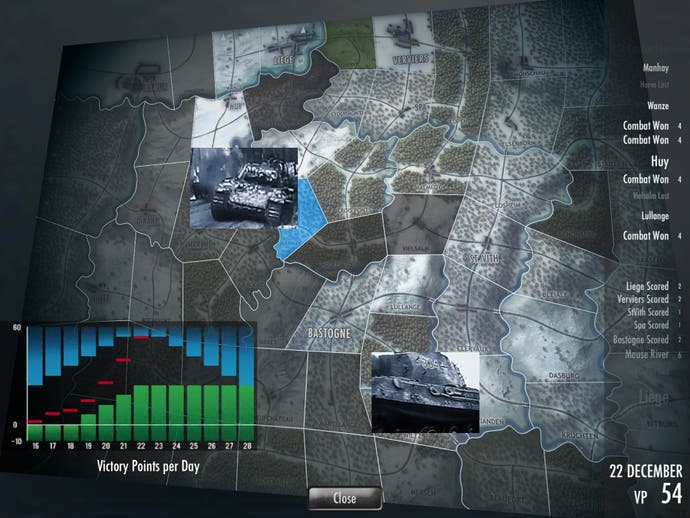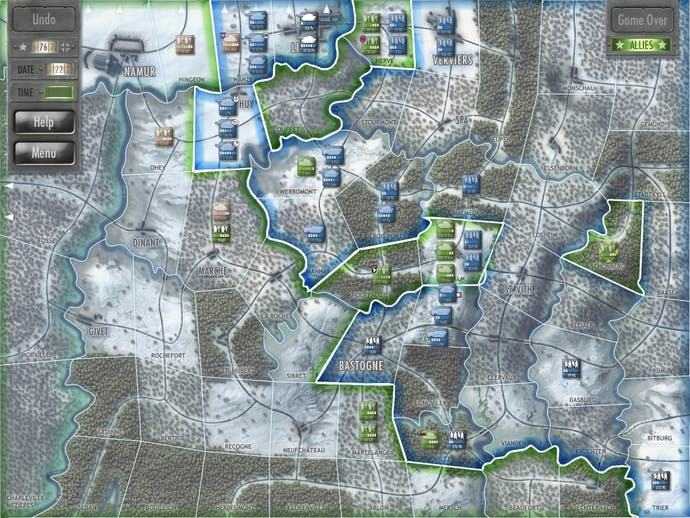Battle of the Bulge review
Advance Wars advanced.
One of my most vivid memories is watching an Armistice Day service as a kid and, during the minute's silence, noticing old people crying. This was a puzzle. For me, and I suspect for you too, the World Wars are something that happened a long time ago - not only in the literal sense, but in the sense in which the actual experience is fading out to the point of vanishing entirely. My parents grew up among people who had lived through and fought in the Second World War, whereas I vaguely remember a great-uncle who'd been in the air force. Even as a kid, I understood that I didn't understand something. The World Wars seemed like history rather than real and recent events.
This may seem a rather heavy introduction to a strategic wargame, but Battle of the Bulge is an exceptional production. It combines its strategy core with a wealth of supplementary material, and more importantly it hard-wires the reality of the battle's circumstances into its mechanics. The game plays out over 14 days, and over this time certain incidents will always occur (such as random German tanks running out of fuel) and reinforcements will arrive on the day they did arrive - all of which can be seen on the calendar.
Battle of the Bulge is an asymmetrical strategy game, both sides having highly pronounced strengths and weaknesses - as well as totally different objectives. But what's amazing about it is that, to play the game with any competence, you have to understand what the Battle of the Bulge was. It was the last throw of the die for Nazi Germany, basically, which was losing on all fronts, and a near-impossible task for the generals charged with executing it; yet it was also the biggest single battle the United States has ever fought and one of the bloodiest. At its end there are casualties of just under 200,000 across both sides and the Axis is broken.

Battle of the Bulge allows you to play as either side against a choice of AI commanders (Patton and Montgomery for the Allies, Walter Model and Gerd von Rundstedt for the Axis), and can also be played locally or online with asynchronous turns. The game is set on a beautiful map of the Ardennes region that's half illustration and half symbol, with important terrain like towns and forests easily identifiable. Such clarity extends to the units, which are neat coloured tokens that instantly communicate the essential information: how much firepower and health it has, whether it's an elite unit, whether it's out of fuel or ammo.
It's easy to make moves in Battle of the Bulge - in fact, it's more or less Advance Wars - but what is going on under the hood is vastly different. I don't think I've ever seen a game combine simplicity and simulation so well, pulling you in with its ease of play and then bamboozling with the level of depth in its calculations.
The similarities to Advance Wars, needless to say, tempt you to play it like Advance Wars, so my first few attempts at command ended in crushing defeat. Then you get interested in the terrain, the defenders' advantage, the approach route, the precise make-up of the units you're attacking - and the cold, irresistible drop-down menu that spells it all out. Once you have even a vague grasp of what's going on, the time spent chewing over numbers and possibilities is enormous; even the decision to move a unit to a new location becomes fraught. (If you're interested in just how much thought can go into a single piece of territory, I heartily recommend this fascinating write-up on the town of Bastogne.)
Battle of the Bulge is easily the most educational game I've ever played.

The Battle of the Bulge was a surprise offensive, so in keeping with this the first three moves of any game are made by the Axis, and the Allies are heavily under-strength for the first part of the conflict. After the initial assault turns are passed back and forth across the span of a day, with anything from 0 to 180 minutes passing between each one at random, at 6pm it's dusk and you move to the next day in the calendar.
This structure means that both sides are racing against the clock but for different reasons. If playing as the Axis, you need to break through the initially weak Allied forces and cross the River Meuse before establishing a map presence that can somehow hold back the ferocious and inevitable counter-attack. If playing as the Allies, it's all about delaying tactics. Just as in the real war, where slowing down the German advance at key locations allowed reinforcements to turn the tide, the key is surviving the early assaults and then turning the tables. The rhythm this gives the game is Battle of the Bulge's greatest achievement, with a gradual and huge swing of resources towards the Allies played off against the early and ongoing brute force of the German Panzer divisions.
This also ties into the one mechanic that gives a touch of humanity to the units: they sometimes retreat. This is randomised depending on how combat's going, but there's always a chance that a unit down to its last legs will surrender its turf and retreat - a little annoying when you're hoping they'd slow down the Germans for as long as possible, but also a necessary mechanic. It's hard to kill any unit outright without overwhelming firepower, but often you can force them out of locations you want to hold.

The craziest thing you realise while playing Battle of the Bulge is that all its units are, of course, representations of real units. The Allies have an amazing group of soldiers near Elsenborn at the start, which I googled and found out was the U.S. Army's 2nd Infantry Division - who were already breaching the Siegfried Line when the Battle of the Bulge began but were pulled back as emergency defenders and played a crucial role in slowing down the German advance. And they do! Every single unit has its name at the bottom, and I've spent hours indulging my curiosity about their in-game utility versus the real events.
This is the kind of detail, quite apart from its packed menus and descriptions of aspects of the war, that leads to Battle of the Bulge's greatest achievement: inspiring interest in its source. For me the true purpose of something that aims to educate, whether it be a teacher or a video game, is to instil a sense of curiosity in the student, to make you go off and find out more independently. In the last fortnight I've read Stalingrad by Anthony Beevor, started Kershaw's biography of Hitler, read a thousand Wikipedia articles and watched Downfall. Battle of the Bulge is easily the most educational game I've ever played.
Battle of the Bulge is, first and foremost, a hugely enjoyable strategy game, and if you've no interest in the history I'm sure it's possible to appreciate it as just that. But the way in which it frames its source absolutely enraptured me, reawakening a long-dormant interest and sparking a search for countless other takes on the battle and its wider context - many of which, it has to be said, didn't come close. To say that Battle of the Bulge gives you a greater understanding of the Second World War and its human cost would in the strictest sense be untrue. But it encourages you in that direction and shines enough light to guide an inquisitive mind further. A fantastic game and a fitting tribute, Battle of the Bulge is unique.

